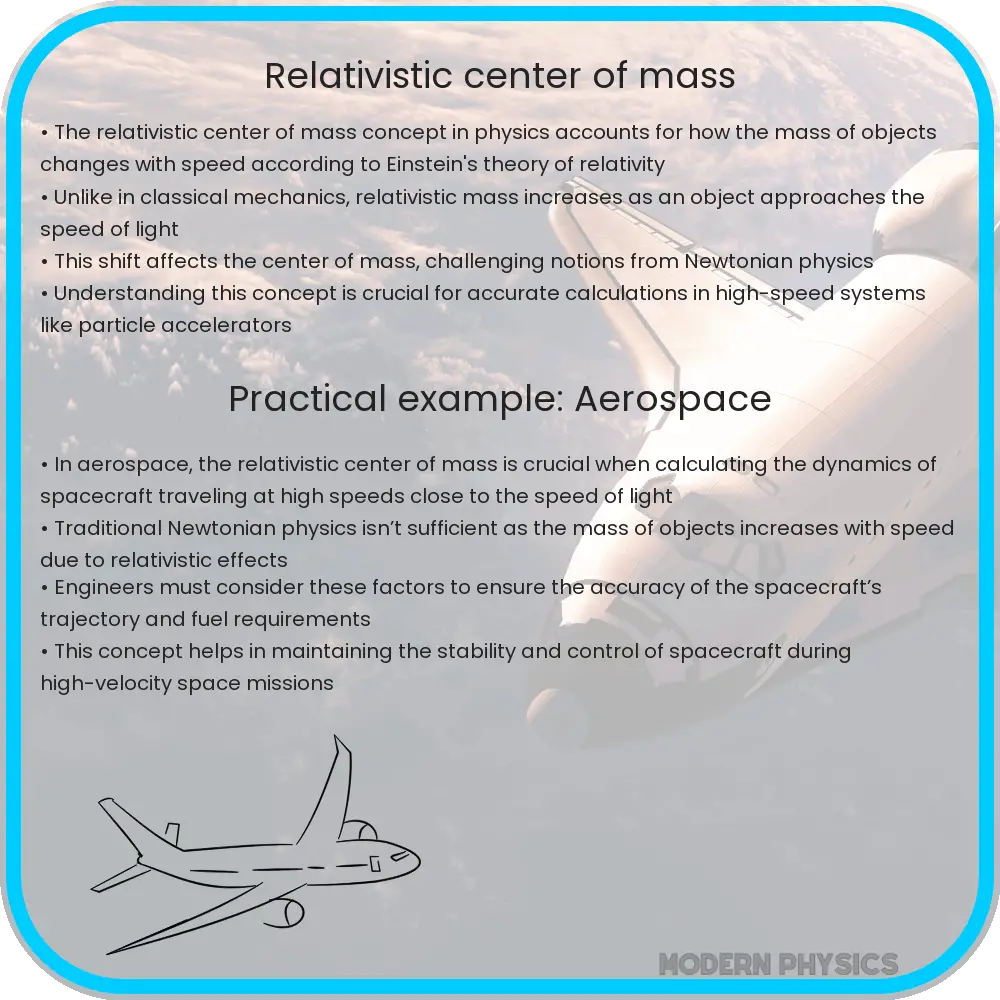Explore the fascinating concept of the relativistic center of mass in special relativity, its impact on physics, and real-world applications.

Understanding the Relativistic Center of Mass in Special Relativity Dynamics
The concept of the center of mass in classical mechanics is straightforward: it’s the average position of all the mass in a system, weighted by the mass of each component. However, when velocities approach the speed of light, special relativity dramatically alters our understanding of mass, momentum, and consequently, the center of mass. The relativistic center of mass is not only a fundamental concept in special relativity dynamics but also crucial in understanding high-speed particle interactions and astrophysical phenomena.
Special Relativity and Its Impact on Mass
Special relativity, introduced by Albert Einstein in 1905, revolutionized physics by establishing that the laws of physics are the same for all non-accelerating observers and that the speed of light within a vacuum is the same no matter the speed at which an observer travels. A key consequence of special relativity is the relativistic mass, given by \( m = \frac{m_0}{\sqrt{1 – \frac{v^2}{c^2}}} \), where \( m_0 \) is the rest mass, \( v \) is the velocity of the object, and \( c \) is the speed of light.
Relativistic Momentum and Center of Mass
In classical mechanics, momentum (\( p \)) is simply the product of mass and velocity (\( p = mv \)). However, under special relativity, the formula becomes \( p = \gamma m_0 v \), where \( \gamma = \frac{1}{\sqrt{1 – \frac{v^2}{c^2}}} \) is the Lorentz factor. This modification has profound implications for the concept of the center of mass in systems moving at relativistic speeds.
The center of mass in a relativistic context, often referred to as the center of momentum frame, is the point where the total momentum of the system is zero when observed from this frame of reference. This definition is vital in analyzing systems like colliding particles in accelerators, where velocities can be a significant fraction of the speed of light.
To calculate the relativistic center of mass, one must consider both the relativistic mass and the velocities of the particles. The position of the relativistic center of mass (\( R \)) for a system of particles can be calculated using the formula \( R = \frac{\sum (\gamma m_i r_i)}{\sum (\gamma m_i)} \), where \( r_i \) and \( m_i \) are the position and rest mass of the \( i^{th} \) particle, respectively.
This formulation ensures that even in the realm of high velocities, the principles of conservation of momentum and energy hold true, albeit with modifications to account for relativistic effects. The relativistic center of mass is not just a theoretical concept but has practical applications in modern physics, particularly in understanding and predicting the outcomes of high-energy particle collisions.
Applications and Implications of Relativistic Center of Mass
The relativistic center of mass concept has significant implications in various fields of physics. In particle physics, it is instrumental in analyzing particle collisions at high energies, as seen in particle accelerators like the Large Hadron Collider (LHC). Here, understanding the relativistic center of mass enables physicists to predict the outcomes of collisions and understand fundamental particles and forces. In astrophysics, this concept helps in studying high-speed stellar objects and phenomena such as neutron star collisions, where velocities are a substantial fraction of the speed of light.
Another intriguing application is in the domain of relativistic engineering. As humanity progresses towards technologies like spacecraft moving at relativistic speeds, understanding the dynamics of such systems becomes crucial. The relativistic center of mass plays a key role in designing and navigating these high-speed spacecraft, ensuring accurate trajectory and stability analyses.
Challenges and Future Directions
Despite its importance, calculating the relativistic center of mass poses significant challenges, especially in complex systems with numerous particles moving at different velocities. Advanced computational techniques and a deeper understanding of relativistic physics are required for more accurate calculations and predictions. As technology advances, especially in the field of particle accelerators and space exploration, the practical applications of these calculations will become increasingly significant.
Conclusion
In summary, the concept of the relativistic center of mass in special relativity dynamics offers a profound insight into the behavior of systems at high velocities. It extends the classical idea of the center of mass to scenarios where relativistic effects cannot be ignored. This concept is not just a theoretical construct but has practical applications in modern physics, especially in particle physics and astrophysics. As we continue to explore the universe and develop technologies that operate at or near the speed of light, understanding and applying the principles of the relativistic center of mass will become increasingly important. This concept stands as a testament to the ever-evolving nature of our understanding of the universe, challenging and refining our knowledge of fundamental physics.
